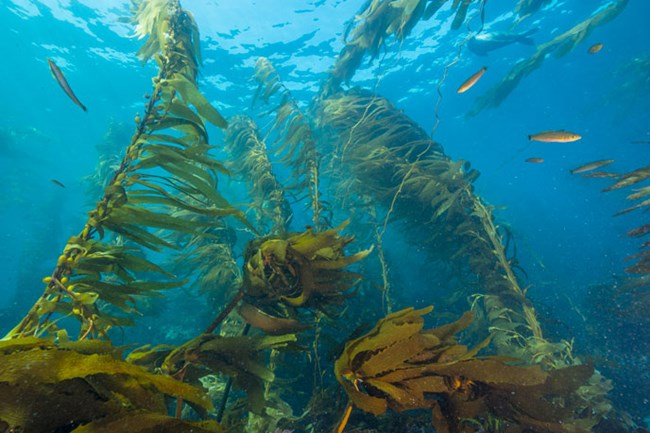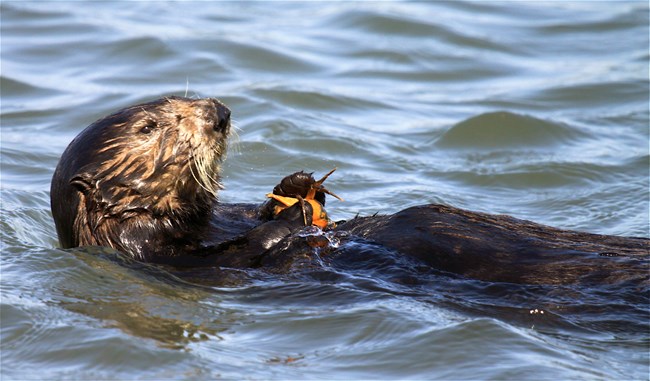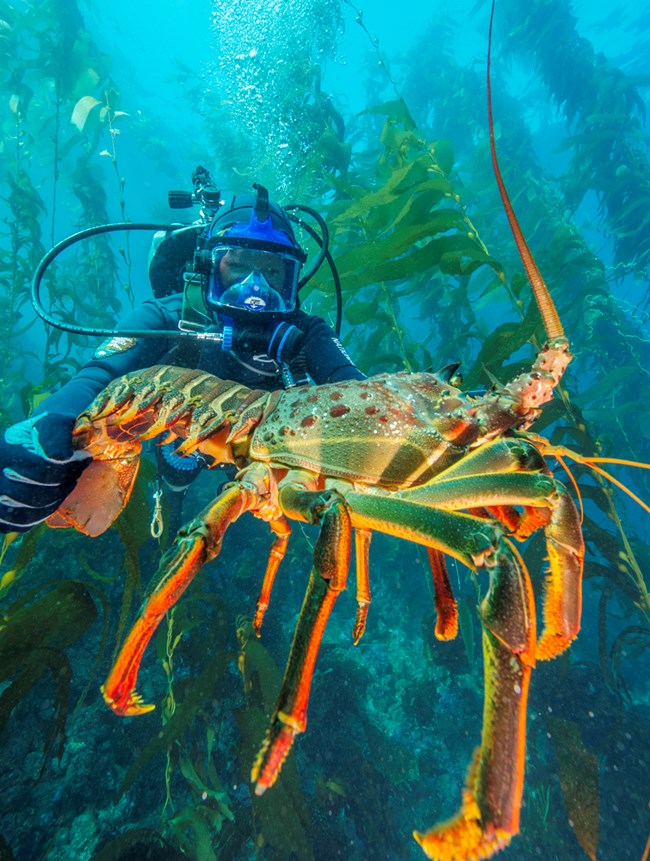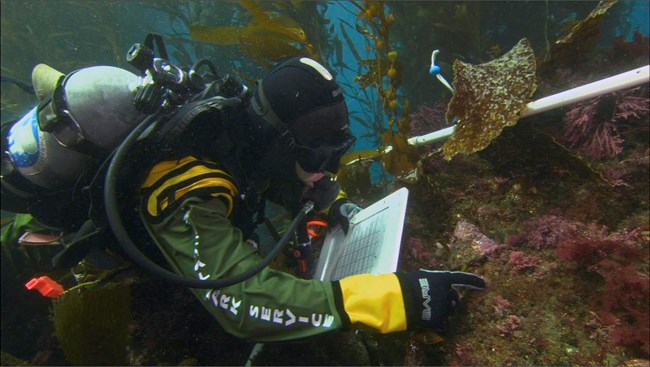
Kelp is a type of seaweed (or marine algae) that describes 27 genera worldwide. Some kelps form dense patches on rocky reefs resembling a forest of trees underwater and are referred to as kelp forests. One third of southern California’s kelp forests are found within Channel Islands National Park and Channel Islands National Marine Sanctuary. Kelp forests at the Channel Islands experience a mixing of both warm water currents from the south and cold water currents from the north creating a highly productive system and supporting an incredible abundance and diversity of marine life. Some examples of warmer water species include the Garibaldi fish, California moray eel and the California spiny lobster. Examples of colder water species include black rockfish, red abalone and the sunflower star. Over 1,000 species of marine plants and animals can be found within Channel Islands kelp forests. The kelp forest floor is teeming with benthic invertebrates and understory algae. The kelp holdfasts, stipes (stalks) and blades create a three dimensional world of incredible biological diversity by providing numerous fish and invertebrates with food and protection. The thick kelp canopy acts as a shelter from predators and nursery habitat for juvenile fish. 
Lilian Carwell / USFWS If the balance of the kelp forest community is upset, dramatic consequences can ensue. For instance, sea otters were once top predators in the kelp forests at the Channel Islands. By 1900, hunting had driven them close to extinction at the islands. Without sea otters, sea urchin populations eventually exploded and overgrazed the kelp, leaving behind large areas of “urchin barrens.” Sea otter populations, while recovering in Central California, have not yet returned to Channel Islands National Park. Today, California sheephead, spiny lobsters, and sunflower stars are the primary consumers of sea urchins that help keep their populations in check. Humans also harvest sea urchins both commercially and recreationally at the Channel Islands in areas that are not designated as marine protected areas. 
Yasmeen Smalley / NPS Kinds of Kelp The kelp forests at the Channel Islands harbor a spectacular collection of seaweeds. Understory algae often carpet the rocky reefs leaving no evidence of the rock beneath. Of the 27 groups of kelp worldwide, nine are represented in the park. Giant kelp (Macrocystis pyrifera) is the largest and most prominent species in the kelp forests at the Channel Islands, while elk kelp (Pelagophycus porra) is among the most unique. 
Brett Seymour / NPS Importance In addition to their ecological significance, kelp forests are also valued for other reasons. For instance, they support economically important commercial and recreational fisheries, as well as non-consumptive diving, snorkeling, and wildlife viewing. Animals such as the red sea urchin, spiny lobster and rock crab are just a few of the species that are fished at the Channel Islands. In the past, kelp and other seaweeds were harvested for carrageenan and alginates, ingredients that are used as thickeners and stabilizers in many products from ice cream to toothpaste to shampoo. Kelp harvesting continues at low levels elsewhere in California, but kelp farming in other regions of the world has replaced wild harvesting as the world’s primary source of kelp. For many SCUBA divers and underwater photographers, kelp forests are a favorite destination offering experiences to observe the unique collection of marine life found only at the Channel Islands. The kelp forests at the Channel Islands are some of the best examples in the world of this rich, diverse, and unfortunately threatened ecosystem. Current Threats and Conservation/Stewardship Efforts There are many current threats to the health of kelp forest ecosystems around the world. These threats include over-fishing, pollution, invasive species, disease, ocean acidification, warming ocean temperatures, and sea level rise. For instance, an invasive brown alga called Sargassum horneri now dominates large swaths of kelp forest habitat at the islands, and while it’s impacts are not yet fully understood, the kelp forests of the Channel Islands are being substantially altered. 
NPS Channel Islands National Park's Kelp Forest Monitoring Program documents such changes as as it monitors the health of the kelp forest ecosystem, including over 70 different groups of kelp forest species. The resulting information helps the California Department of Fish and Wildlife to better manage the kelp forests at the Channel Islands. For example, information from park monitoring was instrumental in establishing state Marine Protected Areas at the Channel Islands. These marine reserves protect nearly 21% of park waters, including kelp forests and other marine habitats, from the threat of over-fishing so that species are better able to thrive both inside and outside of the protected areas. Education is another way Channel Islands National Park works to foster marine resource conservation and stewardship. Partnerships and programs like Channel Islands Live, Channel Islands Live Distance Learning, and Teens for Oceans enable people of all ages to learn about and experience the fascinating but seldom seen kelp forest ecosystem. |
Last updated: June 10, 2019
